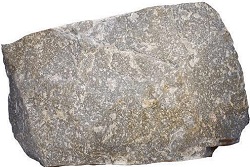- A consolidated material composed of grains of one or more minerals.
Classification of Rocks
1. Igneous Rocks
-Rocks formed when molten material from the earth's interior cools and solidifies
on or beneath the earth's surface.
Types of Igneous Rocks
a) Intrusive Igneous Rocks
- Rocks formed when magma cools and solidifies below the earth's surface e.g. granite, diorite, gabbro, peridotite.
- Have coarse texture as a result of slow cooling giving minerals more time to form large crystals.
- Are classified further into two:
- Hypabyssal rocks - intrusive igneous rocks which are near the earth's surface.
- Plutonic rocks - intrusive igneous rocks which are deep below the surface.
(b) Extrusive Igneous Rocks
-Rocks formed when lava solidifies on the earth's surface.
-Have fine texture due to fast cooling giving minerals less time to collect together
to form larger crystals.
They are of two types namely:
- Volcanic Ejecta
-Extrusive igneous rocks are formed When ash and lava ejected from underground as they fall on the earth's
surface e.g. pumice. When dust and ash ejected settle on the ground and get compressed to form
a rock e.g. tuff.
- Lava Flows
-Extrusive igneous rocks formed when basic lava flows over a considerable
distance then cools and solidifies e.g. basalt and obsidian.
2. Sedimentary Rocks
-Rocks formed when particles of other rocks are laid down and compressed into
layers or when plant and animal remains are buried and compressed and
compacted.
 A Sandstone- Type of a Sedimentary Rock (Picture Courtesy)
A Sandstone- Type of a Sedimentary Rock (Picture Courtesy)
- When they are laid down a layer is formed.
- As deposition continues additional layers are formed which compress the
lower layers into a hard mass.
Types of Sedimentary Rocks
a) Mechanically Formed Sedimentary Rocks
-Sedimentary rocks formed when weathered igneous or metamorphic rocks are
deposited and compacted e.g. sandstone and shale.
b) Organically formed Sedimentary Rocks
-Sedimentary rocks formed when animal and plant or animal remains are buried,
compressed and compacted.
- Organically formed sedimentary rocks can be classified into:
- Calcareous rocks - rich in calcium carbonate e.g. chalk and limestone.
Coral rocks are formed from remains of sea polyps which extract lime from the
sea, build shells for protection, attach themselves to each other and rocks to live in
colonies, then die and shells to form coral rocks.
- Ferruginous Rocks - rich in iron e.g. ironstone.
- Siliceous Rocks - rich in silica e.g. diatomite.
- Carbonaceous Rocks - rich in carbon e.g. coal.
c) Chemically formed Sedimentary Rocks
-Sedimentary rocks formed when materials dissolved in water chemically react
forming new substances then water evaporated leaving layers of those salts.
Chemically formed sedimentary rocks can be classified into:
- Carbonates e.g. trona and dolomite
- Sulphates - sulphate compounds
- Chlorides e.g. halite
- Silicates e.g. flint
- Iron stones e.g. haematite and limonite
3. Metamorphic Rocks
- Rocks which have changed their physical appearance and chemical properties as a
result of subjection to great heat and pressure e.g
- Gneiss from granite
- Slate from clay
- Marble from limestone
- Quartzite from sandstones
 A Quartzite rock - A Chemically Formed Rock (Picture Courtesy)
A Quartzite rock - A Chemically Formed Rock (Picture Courtesy)
Distribution of Major Rocks in Kenya
Eastern Kenya region
The major rocks are:
-
Metamorphic rocks e.g.
marble in parts of Machakos
and
schist and gneiss in parts of Kitui.
-
Volcanic rocks in Yatta plateau and Kapiti plans.
-
Sedimentary rocks e.g. limestone rocks used in Bamburi for cement
manufacturing.
Coastal Region
- Major rocks are
sedimentary rocks e.g. limestone used in Bamburi for
cement manufacture.
- There are
volcanic rocks in Tsavo rich in ground water resources.
Northern and N.E Region
- Dominated by
sedimentary sands.
- There are
volcanic rocks in Mt. Marsabit and around Rift Valley.
Rift Valley and Kenya Highlands
- Dominated by
volcanic rocks.
- There are
metamorphic rocks which have resulted from changing of
igneous rocks.
L. Victoria Basin
-
Granite and gneiss dominate Western Kenya where they form high rocky
hills called granitic tors common in Kisii, Maragoli and Bunyore areas.
-
Sedimentary rocks deposited by rivers e.g. Nyando, Nzoia, Yala and
Sondu.
Significance of Rocks
- Rocks weather to form soil which is important in agriculture
- Form aquifers which store ground water which forms springs which form
rivers and wells which provide water for domestic and industrial use
- Some rocks are sources of building materials e.g. igneous rocks are used to
make ballast and limestone rocks are used as building blocks and raw
material in cement manufacturing
- Phosphate and nitrate rocks are used to make fertilizer used in agriculture
- Granitic tors of W. Kenya and high volcanic peaks such as those of Mt.
Kenya are a tourist attraction which brings foreign exchange
- Pumice is used as a scrubbing stone
- A rock such as coal is used as fuel for heating, smelting of iron and thermal
electricity generation
- Source of minerals e.g. oil and coal is associated with sedimentary rocks


